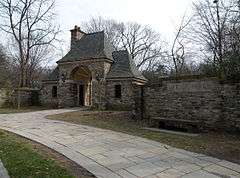Frick Park
Frick Park is the largest municipal park in Pittsburgh, Pennsylvania, covering 644 acres (2.61 km2). It is one of Pittsburgh's four historic large parks.
| Frick Park | |
|---|---|
 Reynolds St. Entrance | |

| |
| Type | Municipal Park |
| Location | Pittsburgh, Pennsylvania |
| Coordinates | 40.432314°N 79.904904°W |
| Area | 644 acres (2.61 km2) |
| Created | 1919 |
| Operated by | City of Pittsburgh Citiparks, Pittsburgh Parks Conservancy |
| Website | www.pittsburghparks.org/frick |
The park began when Henry Clay Frick, upon his death in 1919, bequeathed 151 acres (0.61 km2) south of Clayton, his Point Breeze mansion (which is now part of the Frick Art & Historical Center). He also arranged for a $2 million trust fund ($29.5 million today) for long-term maintenance for the park, which opened on June 25, 1927. He did this against his will, but rather acquiesced to his daughter, Helen's debutante wish which he had promised to honor.[1]
Henry Clay Frick's son, Childs Frick, developed his lifelong love of animals in the woods and ravines of the park. Childs Frick went on to be a renowned American vertebrate paleontologist, major benefactor and trustee of the American Museum of Natural History.
Over the years, the park grew from the original land in Point Breeze and now includes Squirrel Hill to the border of Edgewood. In a city that Frick helped to industrialize, it is one of the few areas of steep ravines and mature woods that remain relatively undisturbed, forming a nature reserve of native plants and abundant wildlife. Owls, amphibians, wild turkey, fox, and many mammal species are found in the park.
Frick Environmental Center
The original Frick Environmental Center, completed in 1979,[2] originally housed the City's Environmental Education Program and for many years hosted ecological and other programs related to the park.[3] A fire in 2002 rendered the building functionally unusable.[3] Demolition at the site was completed and construction began in late-2014.[4]
The current, 15,500-square-foot Frick Environmental Center opened to the public in 2016, following a $16 million construction project. The site includes indoor and outdoor classrooms, public restrooms, and other facilities, and has various energy-efficient and green features, include a photovoltaic array and geothermal bore field.[2] The center was certified as LEED Platinium the next year.[5] The Pittsburgh Parks Conservancy operates the center in collaboration with the City of Pittsburgh.[5]
Ecology
The eastern park boundary is Nine Mile Run, a formerly heavily polluted stream which was restored between 2003 and 2006.[6] The addition of 2.2 miles of Nine Mile Run extended Frick Park nearly to the Monongahela River.
Restoration efforts in 2017-18 involved the removal of about 2.6 acres of bush honeysuckle, an invasive plant that had affected the park for some 20 years, displacing native plants. Following the clearance of the honeysuckle, the Pittsburgh Parks Conservancy discovered ten healthy butternut trees. This was a significant discovery since every other tree in the park is thought to be affected by butternut canker, a fungal disease lethal to plants.[7]
Recreational uses
The park includes a playground, known as the Blue Slide playground, and a dog park. An annual Shakespeare in the Park performance occurs in the upper portion of the park.[8]
Sledding on this hill in Frick Park, along Beechwood Boulevard near Nicholson Street, is a popular winter pastime for some local residents. The hill's long, sloping bowl ends in a grouping of trees. Two different approaches down the hill – one shallow and one steep – intersect at the bottom, occasionally resulting in collisions between sledders. Crashing into trees is also an occasional occurrence. As a result, in 2010 the city posted "no sledding" signs for liability reasons.[9]
In popular culture
Pittsburgh rapper Mac Miller's 2011 album Blue Slide Park is named after the park playground.[10] His song "Frick Park Market" is likewise named for a small store near the Point Breeze park boundary.[11] Following Miller's death on September 7, 2018, the park has been a site for vigils in his memory. The park has been renamed "Mac Miller's Blue Slide Park" on Google Maps and "Mac Miller's Blue Slide Playground" on Apple Maps.[12][13]
References
- Frick Park Clay Court Tennis Club history
- Don Hopey, Frick Environmental Center set to open Saturday, Pittsburgh Post-Gazette (September 9, 2016).
- Jan Ackerman (August 5, 2002). "Fire guts Frick Park's environmental center". Pittsburgh Post-Gazette.
- "Construction underway on Frick Environmental Center". NEXTpittsburgh. 2014-08-07. Retrieved 2018-03-03.
- Frick Environmental Center Achieves LEED Platinum Certification, Pittsburgh Parks Conservancy, November 29, 2017.
- "National Model of Restoration: Nine Mile Run | University of Pittsburgh News". www.news.pitt.edu. Retrieved 2018-03-03.
- Andy Kubis, Restoration Work Leads to Big Surprise in Frick Park, Allegeny Front (June 27, 2018).
- Sharon Eberson, Drones, dogs and diapers — all in a day's work for Pittsburgh Shakespeare in the Parks, Pittsburgh Post-Gazette (September 2, 2018).
- Vivian Nereim, City tries to put the skids on sledding in Frick Park, Pittsburgh Post-Gazette, January 13, 2010
- Saponara, Michael (September 10, 2018). "Mac Miller Public Vigil to Be Held at Pittsburgh's Blue Slide Park". Billboard. Retrieved March 11, 2019.
- Sciullo, Maria (August 23, 2011). "'Frick Park Market' music video a hit on YouTube". Pittsburgh Post-Gazette. Retrieved March 11, 2019.
- Monroe, Jazz (September 12, 2018). "Mac Miller Fans Hold Vigil at Pittsburgh's Blue Slide Park". Pitchfork. Retrieved November 7, 2018.
- Mervis, Scott (September 3, 2019). "Organizer of Mac Miller vigil says rapper was like 'a big brother and a friend -- to everyone". Pittsburgh Post-Gazette. Retrieved September 5, 2019.
External links
| Wikimedia Commons has media related to Frick Park (Pittsburgh, Pennsylvania). |